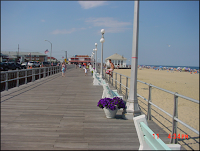Many cities in the northeast
corridor, such as Philadelphia, are confronted with the challenge
of older sewer systems, which combine sanitary and storm sewage in the same
piping. While this was deemed an efficient system in previous eras, the
federal EPA has begun to regulate and fine the discharges from these system
into waterways like the Delaware River. In response, an ever growing field
of green stormwater management has developed, and BSG has been on the forefront
of the investigation and conceptual design of new systems that can separate
stormwater from sanitary flows.
The basic premise of most of
these green designs is an attempt to remove a portion of the stormwater
flow prior to it entering the CSO (Combined Sewer Operating) system. This
can be done in a number of ways, from diverting the flow into raingarden areas
and what are referred to as Bioswales, to the development of stone storage
trenches which capture and, based upon the soil conditions, either infiltrate
or store and slow release the first 1” of rainfall. This involves
calculations of volumes based upon drainage areas and the development of
strategies for the mitigation of green acres.
Birdsall has been instrumental
in looking at alternative design strategies, such as porous paving, and the use
of open space in the management process. We have also created a design
for a Curb Infiltration Unit (CIU) which can be placed flush with a curb and
can divert water to feed adjacent shade trees and plantings. This system
provides a more direct means of infiltration and has shown to be of benefit to
the nearby plantings. These units can also be linked with other storage
methods to provide a larger infiltration system.
Many of these ideas have been
developed as pilot projects and are now being implemented on a city wide
basis. BSG is working to remain in the forefront of these efforts and to
consistently move the bar for creative stormwater management ideas that have
practical applications.

.jpg)

